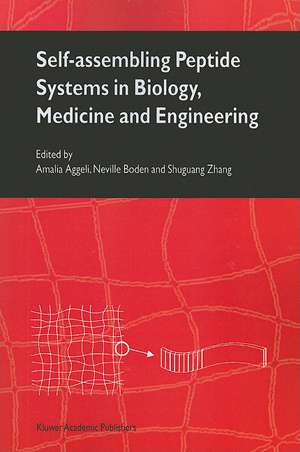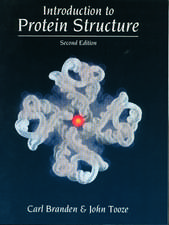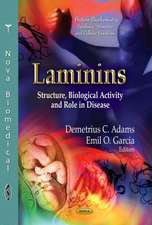Self-Assembling Peptide Systems in Biology, Medicine and Engineering
Editat de A. Aggeli, N. Boden, Zhang Shuguangen Limba Engleză Paperback – dec 2010
| Toate formatele și edițiile | Preț | Express |
|---|---|---|
| Paperback (1) | 1216.30 lei 6-8 săpt. | |
| SPRINGER NETHERLANDS – dec 2010 | 1216.30 lei 6-8 săpt. | |
| Hardback (1) | 1229.91 lei 6-8 săpt. | |
| SPRINGER NETHERLANDS – 31 aug 2001 | 1229.91 lei 6-8 săpt. |
Preț: 1216.30 lei
Preț vechi: 1483.29 lei
-18% Nou
Puncte Express: 1824
Preț estimativ în valută:
232.74€ • 242.52$ • 192.71£
232.74€ • 242.52$ • 192.71£
Carte tipărită la comandă
Livrare economică 03-17 aprilie
Preluare comenzi: 021 569.72.76
Specificații
ISBN-13: 9789048157402
ISBN-10: 9048157404
Pagini: 380
Ilustrații: XII, 364 p.
Dimensiuni: 155 x 235 x 20 mm
Greutate: 0.56 kg
Ediția:2001
Editura: SPRINGER NETHERLANDS
Colecția Springer
Locul publicării:Dordrecht, Netherlands
ISBN-10: 9048157404
Pagini: 380
Ilustrații: XII, 364 p.
Dimensiuni: 155 x 235 x 20 mm
Greutate: 0.56 kg
Ediția:2001
Editura: SPRINGER NETHERLANDS
Colecția Springer
Locul publicării:Dordrecht, Netherlands
Public țintă
ResearchCuprins
Exploiting Peptide Self-assembly to Engineer Novel Biopolymers: Tapes, Ribbons, Fibrils and Fibres.- Ribbon-Like Lamellar Structures from Chain-Folded Polypeptides.- Design of Self-Assembling Peptides as Catalyst Mimetics Using Synthetic Combinatorial Libraries.- Thermodynamics of Protein-Protein and Peptide Interactions.- The Mechanism of Amyloid Formation and Its Links to Human Disease and Biological Evolution.- Transgenic Plants for Large Scale Production of Peptides and Proteins.- Assembly Modulation of Channel-Forming Peptides.- Molecular Casting of Infectious Amyloids, Inorganic and Organic Replication: Nucleation, Conformational Change and Self-Assembly.- Structure and Stabilisation of Self-Assembling Peptide Filaments.- Designed Combinatorial Libraries of Novel Amyloid-Like Proteins.- Design of Synthetic Branched Chain Polymeric Polypeptides for Targeting/Delivering Bioactive Molecules.- Amyloid-Like Fibrils from a Peptide-Analogue of the Central Domain of Silkmoth Chorion Proteins.- Amyloidogenesis of Islet Amyloid Polypeptide (IAPP).- Engineering Self-Assembly of Peptides by Amphiphilic 2D Motifs: ?-to-? Transitions of Peptides.- Model Signal Peptides: Probes of Molecular Interactions During Protein Secretion.- Structure, Folding and Assembly of Adenovirus Fibers.- Solving the Structure of Collagen.- Disulfide Bond Based Self-Assembly of Peptides Leading To Spheroidal Cyclic Trimers.- A New Circular Helicoid-Type Sequential Oligopeptide carrier for Assembling Multiple Antigenic Peptides.- Molecular Recognition in the Membrane: Role in the Folding of Membrane Proteins.- Novel Peptide Nucleic Acids with Improved Solubility and DNA-Binding Ability.- Chiral Lipid Tubules.- ?Tt-Mechanism in the Design of Self-Assembling Structures.- Self-assembling PeptideSystems in Biology and Biomedical Engineering.













